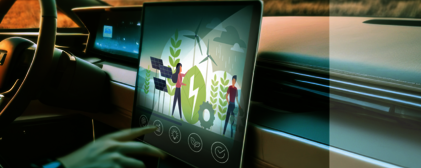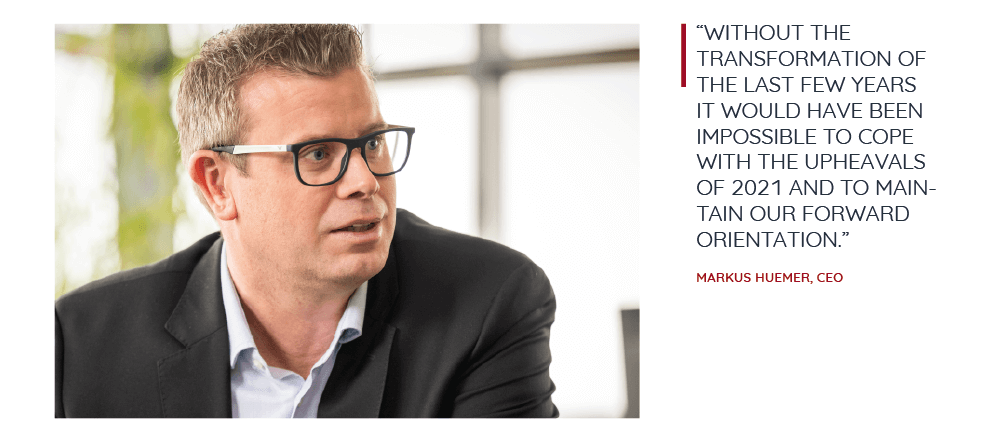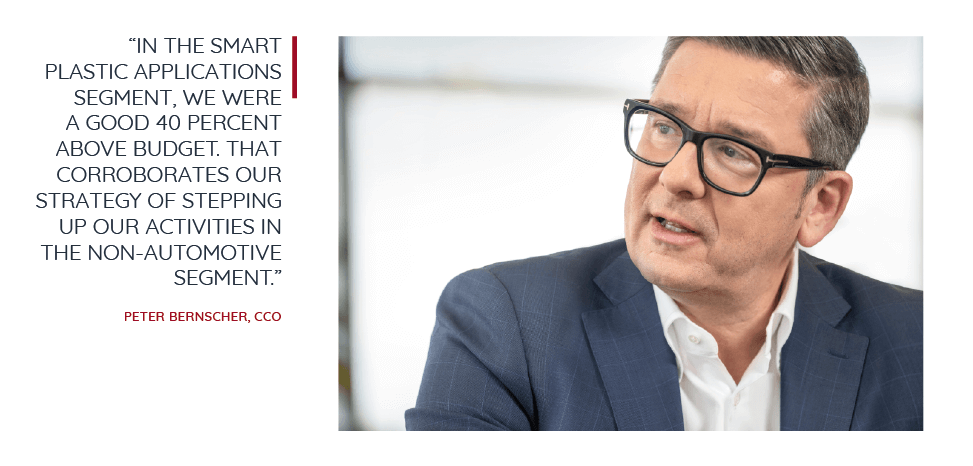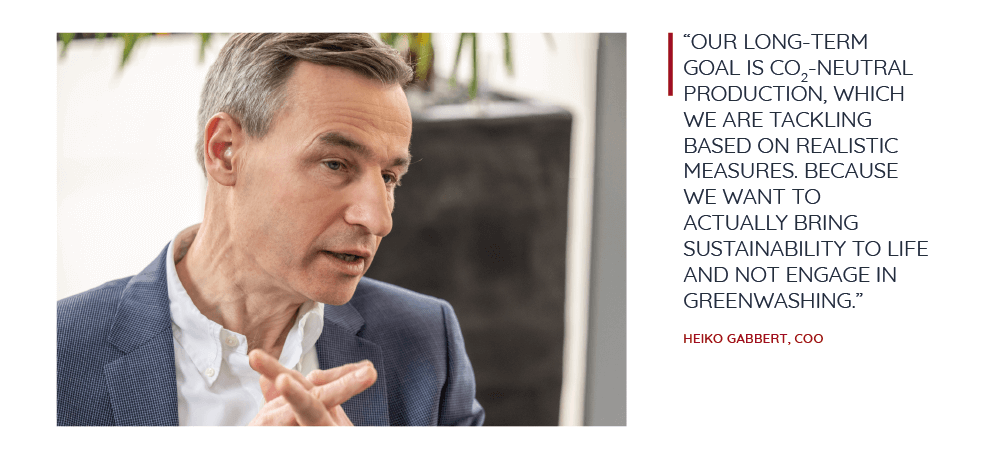You have traditionally scored with technological diversity and innovation, which also play a key role in your strategy. What is happening in this area at the moment?
Heiko Gabbert: Technological diversity is, and will remain, a central success factor for POLYTEC because on this basis we can work on projects that exceed the capabilities of most of our competitors. Here we score through the combination of different technologies, further development of materials and functional integration, and concentrate on sustainable concepts to the best of our ability. For example, we produce underbody panels for electric vehicles in which the battery module and the underbody of the vehicle simply merge – that saves parts and thus leads to weight reduction. Implementing such projects involves a great deal of proactivity on our part and we also take risks – provided that customer benefit and marketability are given. This is something our customers really appreciate.
Peter Bernscher: We have now defined three central engineering streams and got them off the ground successfully. They address the issues that are most important in our view and also effective across the individual product lines: the first stream, high-voltage battery housings, is our response to powertrain electrification. The second stream focuses on developing high-performance materials and simulating their characteristics. That is a central requirement for the design of hybrid structural components as we need a 360-degree overview of the materials’ performance. The third stream deals with the sustainability of products, from material selection and consumption to production methods and recycling. All of this needs to be considered already in the development and comprehensively designed for the entire product chain. Clearly defined roadmaps and milestones are in place for all three streams because we want to deliver the results to the customer as fast as possible. Of course we also pursue various small advance development projects in addition to that.
Which role does e-mobility play?
Peter Bernscher: A crucial one, because e-mobility is a strong trend – if not a paradigm change – which holds as much potential for us as the previously mentioned area of new mobility. This is why we consider e-mobility a great opportunity. Components directly linked to combustion engines only account for about 20 percent of our portfolio today – by 2025 their share will drop to 7 to 8 percent and will be replaced by other products. Incidentally, electric vehicles contain many components that are similar to conventional vehicles – allowing us to draw on our deep expertise. Heat and cooling management, acoustic components and underbodies are just a few important examples. Another advantage: lightweight design is especially important for electric vehicles with respect to their range. Here, we simply transfer proven solutions to a new segment and apply our technology and knowledge in a useful way.
The same applies to new mobility. This segment is also interesting because lower speeds result in different requirements for the components, which of course offers the opportunity to increase the total share of plastic. We can manage the overall lower quantities, coupled with partially increased individualisation, very well with our technologies.
What does the situation in the non-automotive segment look like?
Peter Bernscher: As mentioned before, we have taken the right path by promoting the Smart Plastic Applications Product Line – because this segment grew significantly even in the difficult 2021 financial year. We are focused on two main topics in this area: energy storage and power output on the one hand and logistics on the other – both areas with strong growth dynamics. As decentralised energy production and e-mobility are on the rise, we see high demand for storage modules and charging infrastructure – and we can score with innovative plastic solutions for both. The same is true for logistics: in an economy that increasingly focuses on individual solutions, flexibility and customer proximity, it takes plenty of new logistics solutions to deliver products to the customer quickly and efficiently. Plastic is also the material of choice when it comes to lightweight and reusable containers. But we are also open to product ideas with economic and innovative potential outside these two segments. Overall, we expect sales revenues to increase by up to 40 percent for Smart Plastic Applications over a cycle of five years.
How do you expect the market to develop in the coming years – also against the backdrop of the situation in Ukraine?
Peter Bernscher: Prior to the invasion in Ukraine we saw an upward trend in call-offs, which indicated continued solid demand in the automotive market. The situation also appeared to ease for microchips. Based on this, we were very confident to return to an acceptable sales level. This has again been put into perspective with the crisis in Ukraine. In addition, the uncertainty related to corona continues. The bottom line is that we will have to live with a higher level of uncertainty for months or even years, so there is not much point in making projections.
The silver lining, despite everything, is that the automotive industry’s order books are full: order numbers are higher than they have been in many years, both for cars and commercial vehicles. Never before have we had such long delivery times and such a high production backlog of vehicles that have already been sold. This means that high quantities can be expected as soon as circumstances are somewhat more stable.
Sustainability and ESG were embedded even more firmly within POLYTEC last year, also in organisational terms.
Markus Huemer: We have been working intensively on this topic for years, and its significance is now also more clearly reflected in terms of structure. Since the main scope of control is the deployment of personnel and resources in operations, we allocated these responsibilities to Heiko Gabbert at the board level. Of course this does not mean that we view sustainability only in terms of operations, but rather on a much broader basis. The concept is also firmly anchored in our engineering strategy, for example.
Which aspects are most important in this context and what are your goals?
Heiko Gabbert: The new positioning is driven by three motives and concerns: first of all, aspects such as CO2 emissions, material selection, processing methods and recyclability are gaining importance for our customers, who therefore increasingly demand appropriate measures, certificates and ratings from us. Another important impetus is the EU Taxonomy Regulation as part of the EU Green Deal, which requires transparent and consistent reporting on different parameters from us. As a member of the plastic industry, we are familiar with such requirements and can already prove around 30 percent taxonomy eligibility in turnover, CapEx and OpEx, but of course we will take a very structured approach to this. And last, but not least, we have been striving to reduce our CO2 footprint for years – as has been shown by a wide range of energy-saving and recycling measures. Our long-term goal is CO2-neutral production, which we are tackling based on realistic measures and intermediate targets. Because we want to actually bring sustainability to life and not engage in greenwashing.
![[Translate to Englisch:] [Translate to Englisch:]](/fileadmin/_processed_/e/e/csm_Header_670e97173d.jpeg)
![[Translate to Englisch:] [Translate to Englisch:]](/fileadmin/_processed_/e/e/csm_Header_670e97173d.jpeg)



![[Translate to Englisch:] [Translate to Englisch:]](/fileadmin/_processed_/f/3/csm_Nachhaltigkeit_Menue_629d33ed20.jpg)


